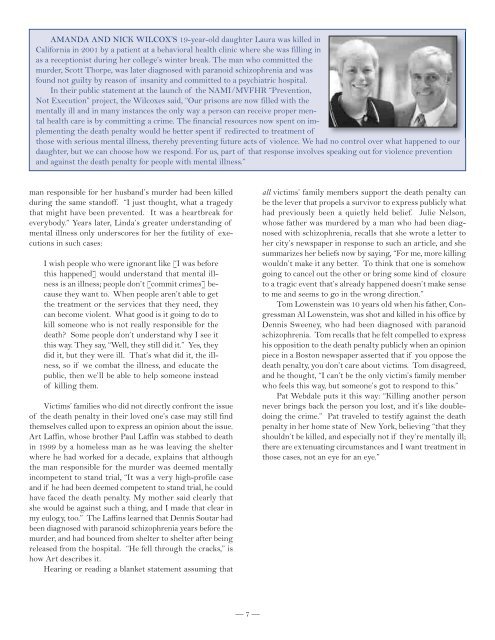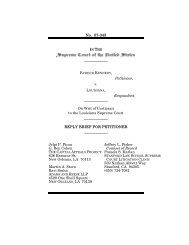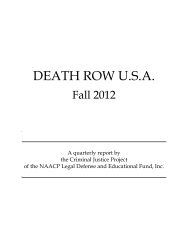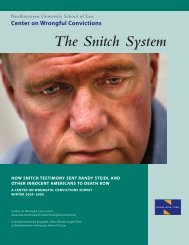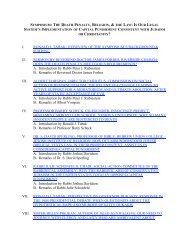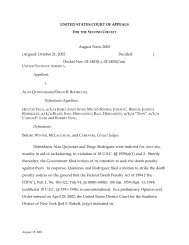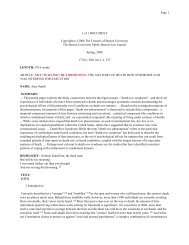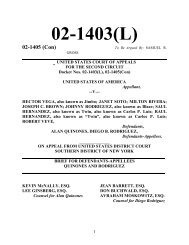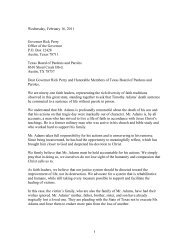Double Tragedies - Families for Human Rights
Double Tragedies - Families for Human Rights
Double Tragedies - Families for Human Rights
- No tags were found...
Create successful ePaper yourself
Turn your PDF publications into a flip-book with our unique Google optimized e-Paper software.
AMANDA AND NICK WILCOX’S 19-year-old daughter Laura was killed inCali<strong>for</strong>nia in 2001 by a patient at a behavioral health clinic where she was filling inas a receptionist during her college’s winter break. The man who committed themurder, Scott Thorpe, was later diagnosed with paranoid schizophrenia and wasfound not guilty by reason of insanity and committed to a psychiatric hospital.In their public statement at the launch of the NAMI/MVFHR “Prevention,Not Execution” project, the Wilcoxes said, “Our prisons are now filled with thementally ill and in many instances the only way a person can receive proper mentalhealth care is by committing a crime. The financial resources now spent on implementingthe death penalty would be better spent if redirected to treatment ofthose with serious mental illness, thereby preventing future acts of violence. We had no control over what happened to ourdaughter, but we can choose how we respond. For us, part of that response involves speaking out <strong>for</strong> violence preventionand against the death penalty <strong>for</strong> people with mental illness.”man responsible <strong>for</strong> her husband’s murder had been killedduring the same standoff. “I just thought, what a tragedythat might have been prevented. It was a heartbreak <strong>for</strong>everybody.” Years later, Linda’s greater understanding ofmental illness only underscores <strong>for</strong> her the futility of executionsin such cases:I wish people who were ignorant like [I was be<strong>for</strong>ethis happened] would understand that mental illnessis an illness; people don’t [commit crimes] becausethey want to. When people aren’t able to getthe treatment or the services that they need, theycan become violent. What good is it going to do tokill someone who is not really responsible <strong>for</strong> thedeath? Some people don’t understand why I see itthis way. They say, “Well, they still did it.” Yes, theydid it, but they were ill. That’s what did it, the illness,so if we combat the illness, and educate thepublic, then we’ll be able to help someone insteadof killing them.Victims’ families who did not directly confront the issueof the death penalty in their loved one’s case may still findthemselves called upon to express an opinion about the issue.Art Laffin, whose brother Paul Laffin was stabbed to deathin 1999 by a homeless man as he was leaving the shelterwhere he had worked <strong>for</strong> a decade, explains that althoughthe man responsible <strong>for</strong> the murder was deemed mentallyincompetent to stand trial, “It was a very high-profile caseand if he had been deemed competent to stand trial, he couldhave faced the death penalty. My mother said clearly thatshe would be against such a thing, and I made that clear inmy eulogy, too.” The Laffins learned that Dennis Soutar hadbeen diagnosed with paranoid schizophrenia years be<strong>for</strong>e themurder, and had bounced from shelter to shelter after beingreleased from the hospital. “He fell through the cracks,” ishow Art describes it.Hearing or reading a blanket statement assuming thatall victims’ family members support the death penalty canbe the lever that propels a survivor to express publicly whathad previously been a quietly held belief. Julie Nelson,whose father was murdered by a man who had been diagnosedwith schizophrenia, recalls that she wrote a letter toher city’s newspaper in response to such an article, and shesummarizes her beliefs now by saying, “For me, more killingwouldn’t make it any better. To think that one is somehowgoing to cancel out the other or bring some kind of closureto a tragic event that’s already happened doesn’t make senseto me and seems to go in the wrong direction.”Tom Lowenstein was 10 years old when his father, CongressmanAl Lowenstein, was shot and killed in his office byDennis Sweeney, who had been diagnosed with paranoidschizophrenia. Tom recalls that he felt compelled to expresshis opposition to the death penalty publicly when an opinionpiece in a Boston newspaper asserted that if you oppose thedeath penalty, you don’t care about victims. Tom disagreed,and he thought, “I can’t be the only victim’s family memberwho feels this way, but someone’s got to respond to this.”Pat Webdale puts it this way: “Killing another personnever brings back the person you lost, and it’s like doubledoingthe crime.” Pat traveled to testify against the deathpenalty in her home state of New York, believing “that theyshouldn’t be killed, and especially not if they’re mentally ill;there are extenuating circumstances and I want treatment inthose cases, not an eye <strong>for</strong> an eye.”__ 7 __


